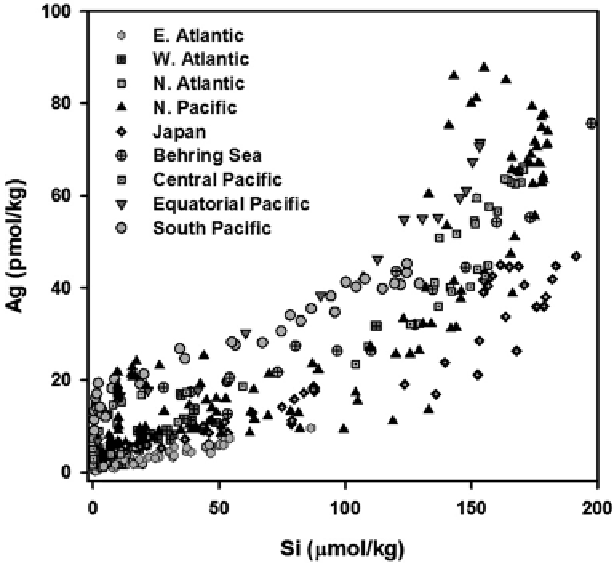Environmental Engineering Reference
In-Depth Information
Fig. 3
Plot of silver (pmol/kg) vs. silicate (
mol/kg) in oceanic waters. Data from Flegal et al.
(
1995
), Rivera-Duarte et al. (
1999
), Ndung'u et al. (
2001
), Zhang et al. (
2001
,
2004
), Ranville and
Flegal (
2005
), and Kramer et al. (
2011
)
ʼ
in the solubility, speciation, and dispersion of silver and copper could subsequently
enrich silver, compared to copper in those plumes, and that enrichment could extend
well beyond the hydrothermal sources, as determined for other trace elements
(e.g., manganese).
The most recent silver data in seawater have been mostly derived from the North
Pacifi c Ocean, and have prompted alternate and contrasting hypotheses on the origins
and cycling of silver in oceanic waters. Figure
5
synthesizes all of the reported silver
vertical concentration profi les in the North Pacifi c (Murozumi
1981
; Martin et al.
1983
; Zhang et al.
2001
,
2004
; Ranville and Flegal
2005
; Kramer et al.
2011
),
excluding those from northeast Pacifi c coastal and estuarine waters (Bloom and
Crecelius
1984
; Flegal and Sañudo-Wilhelmy
1993
; Smith and Flegal
1993
; Rivera-
Duarte and Flegal
1997
; Squire et al.
2002
; Flegal et al.
2007
). These data show that
recent silver concentrations in water samples collected at intermediate depth
(2,400-2,500 m) (Zhang et al.
2001
,
2004
; Ranville and Flegal
2005
; Kramer et al.
2011
) are up to four-fold greater than those previously measured in eastern North
Pacifi c waters (Martin et al.
1983
). The disparity may, in part, result from differences
in sampling protocols (e.g., fi ltered versus unfi ltered samples) and/or analytical
protocols (e.g., UV versus non UV), as mentioned below.

Search WWH ::

Custom Search